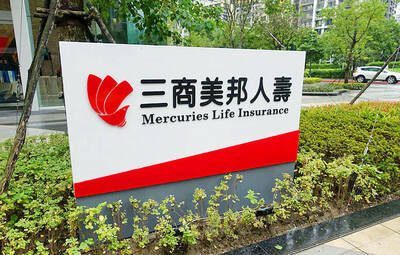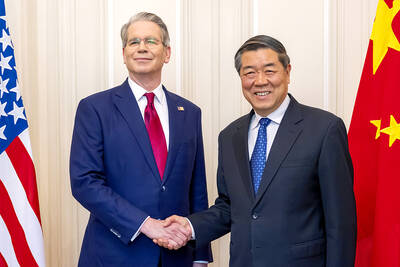MediaTek Inc (聯發科), the nation’s biggest handset chip designer, said yesterday that it had signed a memorandum of understanding (MOU) with Chinese modem chip designer AST Wireless (傲世通) to cooperate on developing chips supporting China’s home-grown TD-SCDMA technology.
The announcement came amid recent speculation that US rival Qualcomm Inc planned to acquire AST Wireless to make faster headway in developing TD-SCDMA handset chips.
MediaTek said the strategic partnership with AST Wireless will help enlarge its TD-SCDMA product portfolio to match rising demand for various end-user terminal devices, and that the deal will enhance the firm’s 3G-and-beyond technological capability, a press release said.
“Continuous technological innovation in the TD-SCDMA industry is one of the major factors driving MediaTek to the overall leading position,” MediaTek said.
The deal also involves China’s biggest mobile operator, China Mobile Ltd (中國移動), which plans to expand China’s 3G market, the Hsinchu-based mobile telephone chipmaker said.
“The deal will enable MediaTek to develop TD-SCDMA chips for China Mobile, better catering to the needs of the telecom company, because of close links between China Mobile and AST Wireless,” said Kenneth Lee (李克揚), a semiconductor analyst with Fubon Securities Investment Services Co (富邦投顧).
New 3G and smartphone chips would create business opportunities that can sustain the company’s growth for several yeas to come, Lee said. Lee reiterated a “buy” rating on MediaTek with a raised target price of NT$700.
In the initial stage, the new handset chips could account for 10 percent of MediaTek’s plans to ship up to 400 million chips this year, Lee said.
AST Wireless is a high-tech startup based in Suzhou and a developer of wireless terminal chipset solutions, according to the company’s Web site. Currently, it is focusing on developing 3.5G HSDPA technology and it plans to move to 3.9G or 4G technology.
China Mobile had more than 5 million TD-SCDMA subscribers at the end of last year, the telecoms operator said.
“The Laguna-U chipset is the successor of the industry’s first HSDPA chipset [Laguna], which was commercially used at the Beijing Olympic Games and can support HSDPA downlink up to 2.8Mbps,” the statement said. “The Laguna-U is now in mass production to support the large-scale commercialization of HSPA in 2010.”
Shares of MediaTek jumped 1.92 percent to NT$584 yesterday, beating the TAIEX, which edged up 0.81 percent.

France cannot afford to ignore the third credit-rating reduction in less than a year, French Minister of Finance Roland Lescure said. “Three agencies have downgraded us and we can’t ignore this cloud,” he told Franceinfo on Saturday, speaking just hours after S&P lowered his country’s credit rating to “A+” from “AA-” in an unscheduled move. “Fundamentally, it’s an additional cloud to a weather forecast that was already pretty gray. It’s a call for lucidity and responsibility,” he said, adding that this is “a call to be serious.” The credit assessor’s move means France has lost its double-A rating at two of the

AI BOOST: Although Taiwan’s reliance on Chinese rare earth elements is limited, it could face indirect impacts from supply issues and price volatility, an economist said DBS Bank Ltd (星展銀行) has sharply raised its forecast for Taiwan’s economic growth this year to 5.6 percent, citing stronger-than-expected exports and investment linked to artificial intelligence (AI), as it said that the current momentum could peak soon. The acceleration of the global AI race has fueled a surge in Taiwan’s AI-related capital spending and exports of information and communications technology (ICT) products, which have been key drivers of growth this year. “We have revised our GDP forecast for Taiwan upward to 5.6 percent from 4 percent, an upgrade that mainly reflects stronger-than-expected AI-related exports and investment in the third

Mercuries Life Insurance Co (三商美邦人壽) shares surged to a seven-month high this week after local media reported that E.Sun Financial Holding Co (玉山金控) had outbid CTBC Financial Holding Co (中信金控) in the financially strained insurer’s ongoing sale process. Shares of the mid-sized life insurer climbed 5.8 percent this week to NT$6.72, extending a nearly 18 percent rally over the past month, as investors bet on the likelihood of an impending takeover. The final round of bidding closed on Thursday, marking a critical step in the 32-year-old insurer’s search for a buyer after years of struggling to meet capital adequacy requirements. Local media reports

RARE EARTHS: The call between the US Treasury Secretary and his Chinese counterpart came as Washington sought to rally G7 partners in response to China’s export controls China and the US on Saturday agreed to conduct another round of trade negotiations in the coming week, as the world’s two biggest economies seek to avoid another damaging tit-for-tat tariff battle. Beijing last week announced sweeping controls on the critical rare earths industry, prompting US President Donald Trump to threaten 100 percent tariffs on imports from China in retaliation. Trump had also threatened to cancel his expected meeting with Chinese President Xi Jinping (習近平) in South Korea later this month on the sidelines of the APEC summit. In the latest indication of efforts to resolve their dispute, Chinese state media reported that